Applied Anthropology: Community Development in East Hampshire
VerifiedAdded on 2023/04/17
|10
|2313
|51
Essay
AI Summary
This essay delves into the realm of applied anthropology, specifically focusing on its application within community development. It begins by providing a theoretical overview of the field, defining community development and its objectives according to various international organizations. The essay then analyzes a case study: a pilot project in East Hampshire, UK, that focused on community empowerment and personalization for a group of individuals with learning disabilities known as Friends United. The project's aims, the stakeholders involved, and the outcomes are examined, highlighting the challenges faced and the successes achieved. Finally, the essay argues for the effective utilization of applied anthropology within the community development project, emphasizing the crucial roles of both research and activism in addressing the needs of disabled people and fostering a more inclusive community. The essay highlights the importance of generating research reports and awareness to facilitate effective long-term outcomes and to address the issues faced by the disabled population.
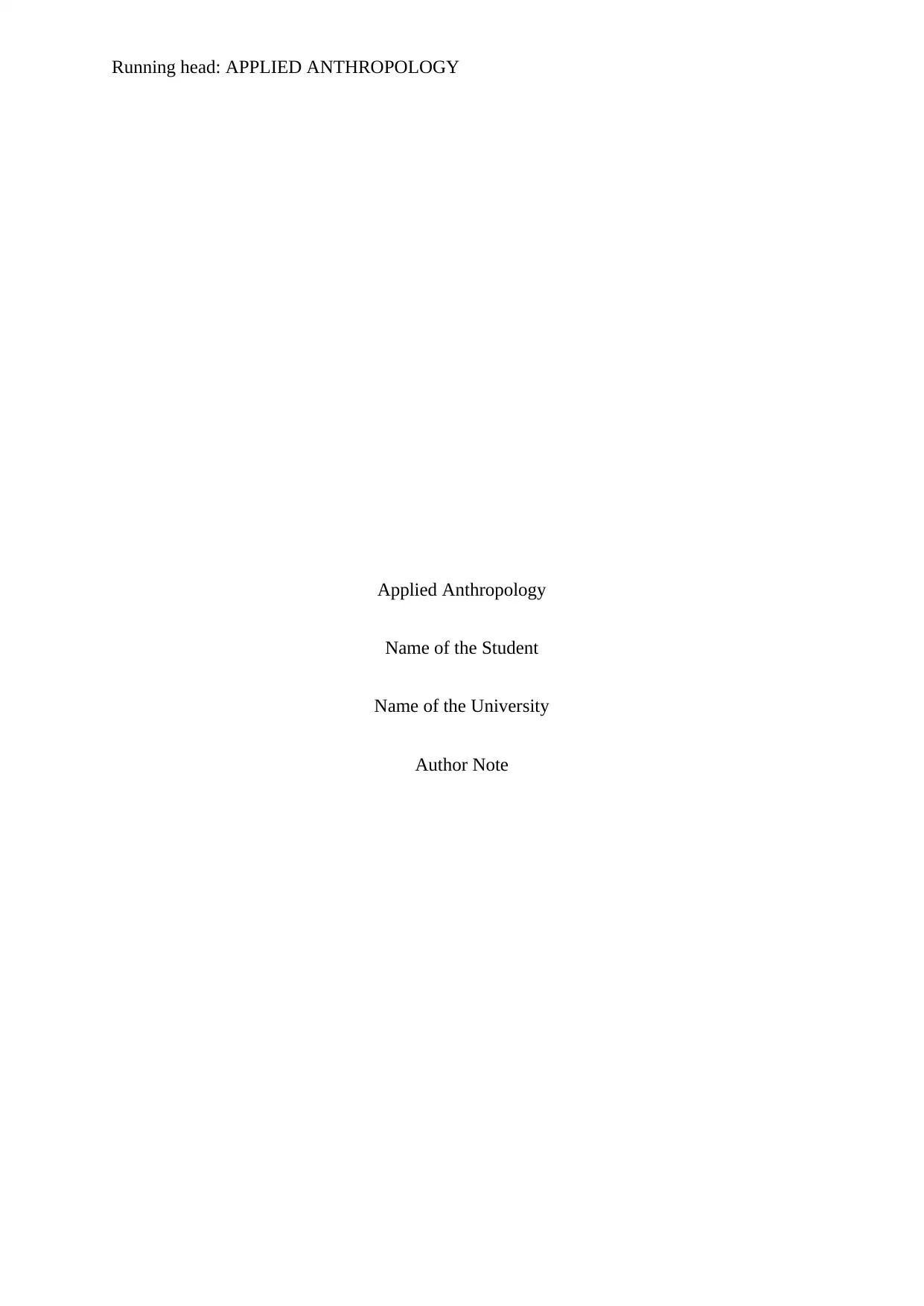
Running head: APPLIED ANTHROPOLOGY
Applied Anthropology
Name of the Student
Name of the University
Author Note
Applied Anthropology
Name of the Student
Name of the University
Author Note
Paraphrase This Document
Need a fresh take? Get an instant paraphrase of this document with our AI Paraphraser
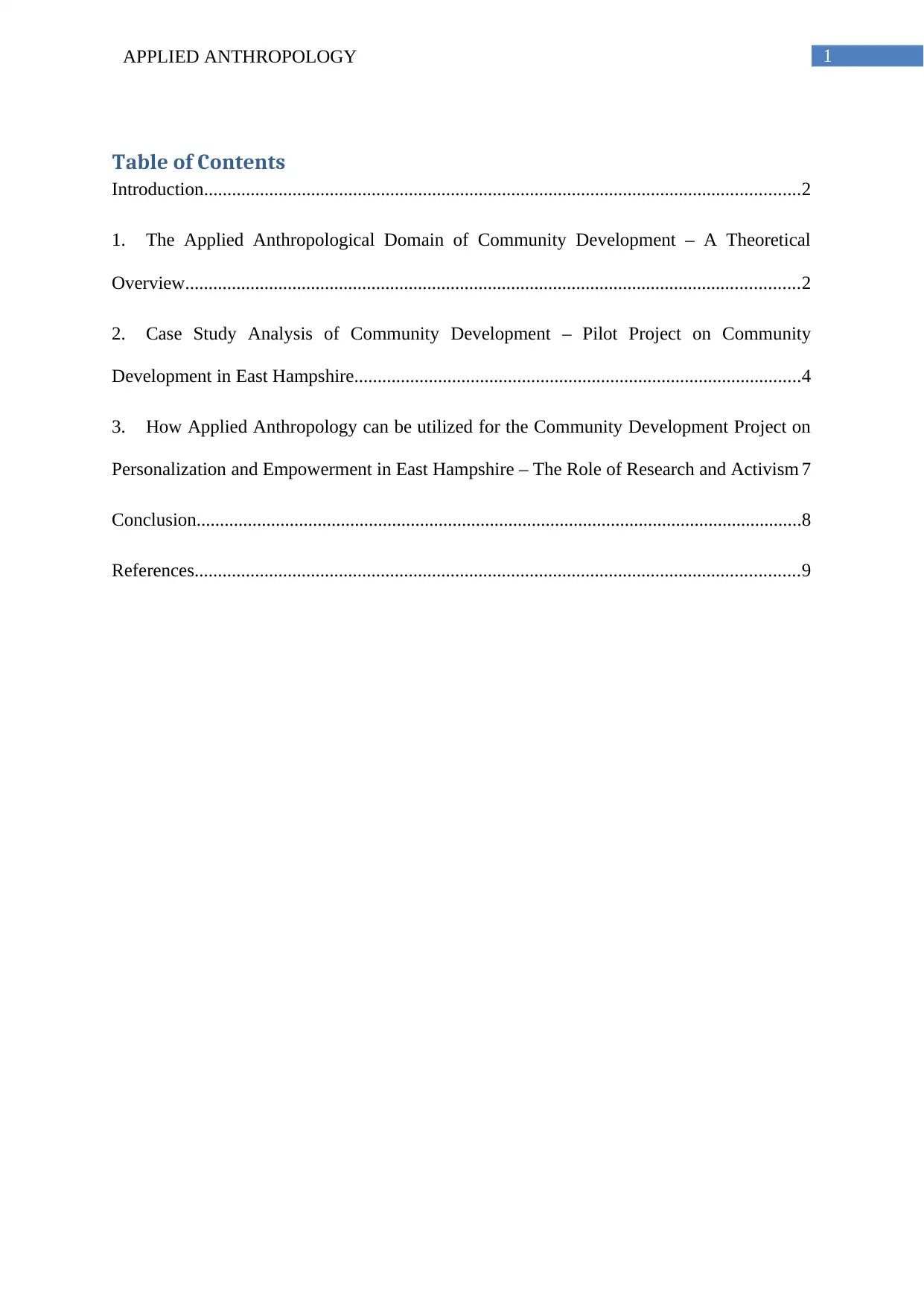
APPLIED ANTHROPOLOGY 1
Table of Contents
Introduction................................................................................................................................2
1. The Applied Anthropological Domain of Community Development – A Theoretical
Overview....................................................................................................................................2
2. Case Study Analysis of Community Development – Pilot Project on Community
Development in East Hampshire................................................................................................4
3. How Applied Anthropology can be utilized for the Community Development Project on
Personalization and Empowerment in East Hampshire – The Role of Research and Activism 7
Conclusion..................................................................................................................................8
References..................................................................................................................................9
Table of Contents
Introduction................................................................................................................................2
1. The Applied Anthropological Domain of Community Development – A Theoretical
Overview....................................................................................................................................2
2. Case Study Analysis of Community Development – Pilot Project on Community
Development in East Hampshire................................................................................................4
3. How Applied Anthropology can be utilized for the Community Development Project on
Personalization and Empowerment in East Hampshire – The Role of Research and Activism 7
Conclusion..................................................................................................................................8
References..................................................................................................................................9
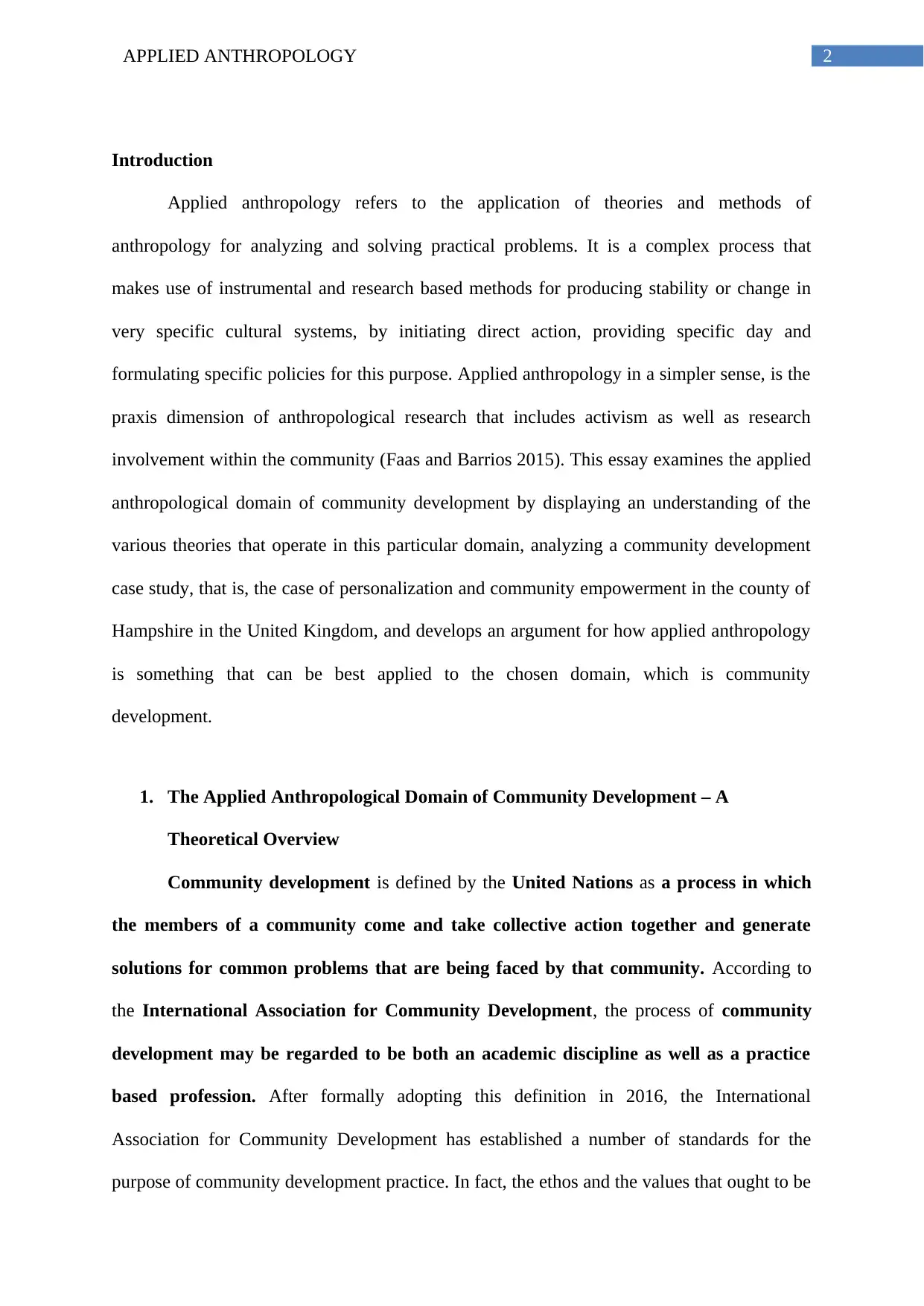
2APPLIED ANTHROPOLOGY
Introduction
Applied anthropology refers to the application of theories and methods of
anthropology for analyzing and solving practical problems. It is a complex process that
makes use of instrumental and research based methods for producing stability or change in
very specific cultural systems, by initiating direct action, providing specific day and
formulating specific policies for this purpose. Applied anthropology in a simpler sense, is the
praxis dimension of anthropological research that includes activism as well as research
involvement within the community (Faas and Barrios 2015). This essay examines the applied
anthropological domain of community development by displaying an understanding of the
various theories that operate in this particular domain, analyzing a community development
case study, that is, the case of personalization and community empowerment in the county of
Hampshire in the United Kingdom, and develops an argument for how applied anthropology
is something that can be best applied to the chosen domain, which is community
development.
1. The Applied Anthropological Domain of Community Development – A
Theoretical Overview
Community development is defined by the United Nations as a process in which
the members of a community come and take collective action together and generate
solutions for common problems that are being faced by that community. According to
the International Association for Community Development, the process of community
development may be regarded to be both an academic discipline as well as a practice
based profession. After formally adopting this definition in 2016, the International
Association for Community Development has established a number of standards for the
purpose of community development practice. In fact, the ethos and the values that ought to be
Introduction
Applied anthropology refers to the application of theories and methods of
anthropology for analyzing and solving practical problems. It is a complex process that
makes use of instrumental and research based methods for producing stability or change in
very specific cultural systems, by initiating direct action, providing specific day and
formulating specific policies for this purpose. Applied anthropology in a simpler sense, is the
praxis dimension of anthropological research that includes activism as well as research
involvement within the community (Faas and Barrios 2015). This essay examines the applied
anthropological domain of community development by displaying an understanding of the
various theories that operate in this particular domain, analyzing a community development
case study, that is, the case of personalization and community empowerment in the county of
Hampshire in the United Kingdom, and develops an argument for how applied anthropology
is something that can be best applied to the chosen domain, which is community
development.
1. The Applied Anthropological Domain of Community Development – A
Theoretical Overview
Community development is defined by the United Nations as a process in which
the members of a community come and take collective action together and generate
solutions for common problems that are being faced by that community. According to
the International Association for Community Development, the process of community
development may be regarded to be both an academic discipline as well as a practice
based profession. After formally adopting this definition in 2016, the International
Association for Community Development has established a number of standards for the
purpose of community development practice. In fact, the ethos and the values that ought to be
⊘ This is a preview!⊘
Do you want full access?
Subscribe today to unlock all pages.

Trusted by 1+ million students worldwide
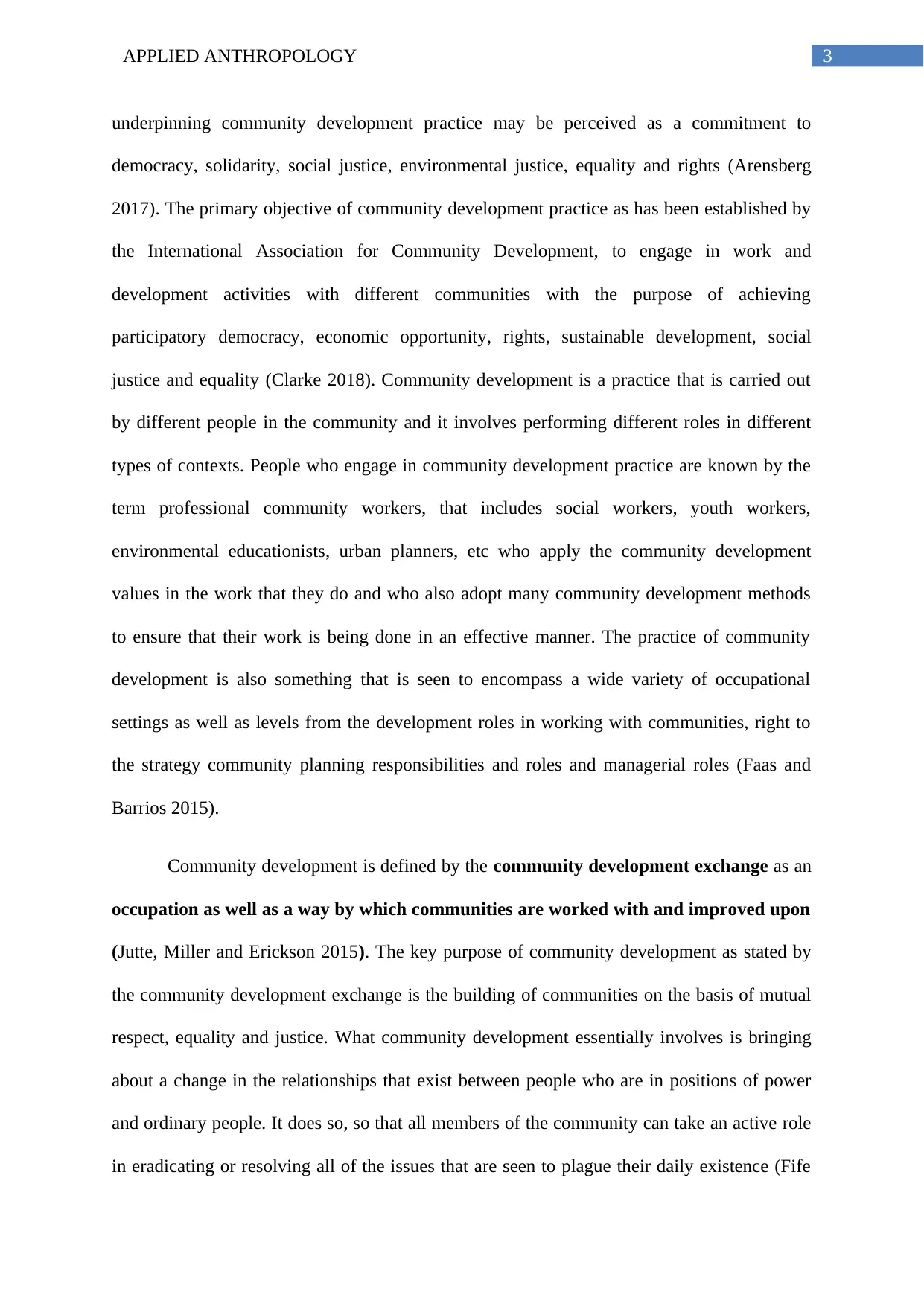
3APPLIED ANTHROPOLOGY
underpinning community development practice may be perceived as a commitment to
democracy, solidarity, social justice, environmental justice, equality and rights (Arensberg
2017). The primary objective of community development practice as has been established by
the International Association for Community Development, to engage in work and
development activities with different communities with the purpose of achieving
participatory democracy, economic opportunity, rights, sustainable development, social
justice and equality (Clarke 2018). Community development is a practice that is carried out
by different people in the community and it involves performing different roles in different
types of contexts. People who engage in community development practice are known by the
term professional community workers, that includes social workers, youth workers,
environmental educationists, urban planners, etc who apply the community development
values in the work that they do and who also adopt many community development methods
to ensure that their work is being done in an effective manner. The practice of community
development is also something that is seen to encompass a wide variety of occupational
settings as well as levels from the development roles in working with communities, right to
the strategy community planning responsibilities and roles and managerial roles (Faas and
Barrios 2015).
Community development is defined by the community development exchange as an
occupation as well as a way by which communities are worked with and improved upon
(Jutte, Miller and Erickson 2015). The key purpose of community development as stated by
the community development exchange is the building of communities on the basis of mutual
respect, equality and justice. What community development essentially involves is bringing
about a change in the relationships that exist between people who are in positions of power
and ordinary people. It does so, so that all members of the community can take an active role
in eradicating or resolving all of the issues that are seen to plague their daily existence (Fife
underpinning community development practice may be perceived as a commitment to
democracy, solidarity, social justice, environmental justice, equality and rights (Arensberg
2017). The primary objective of community development practice as has been established by
the International Association for Community Development, to engage in work and
development activities with different communities with the purpose of achieving
participatory democracy, economic opportunity, rights, sustainable development, social
justice and equality (Clarke 2018). Community development is a practice that is carried out
by different people in the community and it involves performing different roles in different
types of contexts. People who engage in community development practice are known by the
term professional community workers, that includes social workers, youth workers,
environmental educationists, urban planners, etc who apply the community development
values in the work that they do and who also adopt many community development methods
to ensure that their work is being done in an effective manner. The practice of community
development is also something that is seen to encompass a wide variety of occupational
settings as well as levels from the development roles in working with communities, right to
the strategy community planning responsibilities and roles and managerial roles (Faas and
Barrios 2015).
Community development is defined by the community development exchange as an
occupation as well as a way by which communities are worked with and improved upon
(Jutte, Miller and Erickson 2015). The key purpose of community development as stated by
the community development exchange is the building of communities on the basis of mutual
respect, equality and justice. What community development essentially involves is bringing
about a change in the relationships that exist between people who are in positions of power
and ordinary people. It does so, so that all members of the community can take an active role
in eradicating or resolving all of the issues that are seen to plague their daily existence (Fife
Paraphrase This Document
Need a fresh take? Get an instant paraphrase of this document with our AI Paraphraser
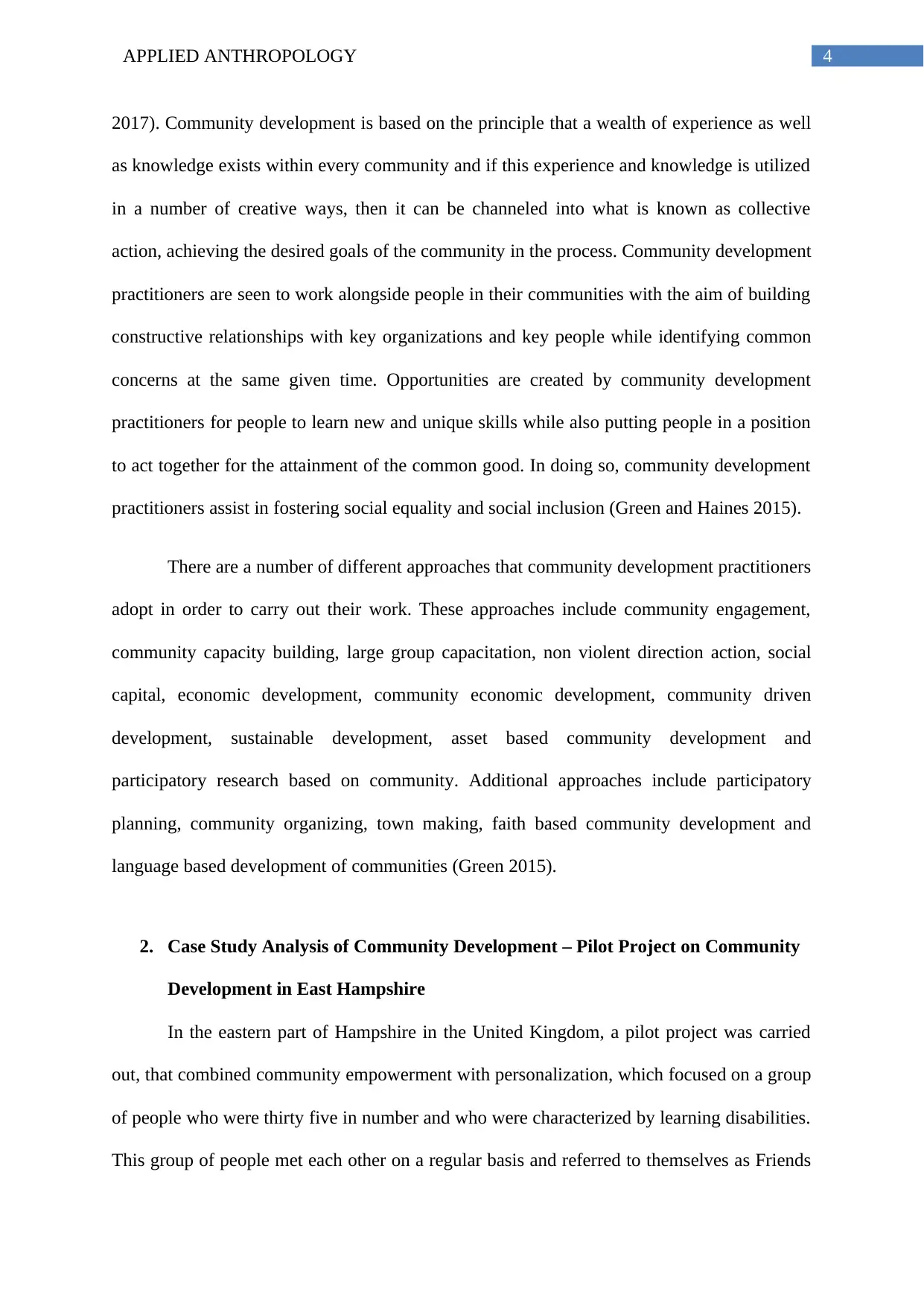
4APPLIED ANTHROPOLOGY
2017). Community development is based on the principle that a wealth of experience as well
as knowledge exists within every community and if this experience and knowledge is utilized
in a number of creative ways, then it can be channeled into what is known as collective
action, achieving the desired goals of the community in the process. Community development
practitioners are seen to work alongside people in their communities with the aim of building
constructive relationships with key organizations and key people while identifying common
concerns at the same given time. Opportunities are created by community development
practitioners for people to learn new and unique skills while also putting people in a position
to act together for the attainment of the common good. In doing so, community development
practitioners assist in fostering social equality and social inclusion (Green and Haines 2015).
There are a number of different approaches that community development practitioners
adopt in order to carry out their work. These approaches include community engagement,
community capacity building, large group capacitation, non violent direction action, social
capital, economic development, community economic development, community driven
development, sustainable development, asset based community development and
participatory research based on community. Additional approaches include participatory
planning, community organizing, town making, faith based community development and
language based development of communities (Green 2015).
2. Case Study Analysis of Community Development – Pilot Project on Community
Development in East Hampshire
In the eastern part of Hampshire in the United Kingdom, a pilot project was carried
out, that combined community empowerment with personalization, which focused on a group
of people who were thirty five in number and who were characterized by learning disabilities.
This group of people met each other on a regular basis and referred to themselves as Friends
2017). Community development is based on the principle that a wealth of experience as well
as knowledge exists within every community and if this experience and knowledge is utilized
in a number of creative ways, then it can be channeled into what is known as collective
action, achieving the desired goals of the community in the process. Community development
practitioners are seen to work alongside people in their communities with the aim of building
constructive relationships with key organizations and key people while identifying common
concerns at the same given time. Opportunities are created by community development
practitioners for people to learn new and unique skills while also putting people in a position
to act together for the attainment of the common good. In doing so, community development
practitioners assist in fostering social equality and social inclusion (Green and Haines 2015).
There are a number of different approaches that community development practitioners
adopt in order to carry out their work. These approaches include community engagement,
community capacity building, large group capacitation, non violent direction action, social
capital, economic development, community economic development, community driven
development, sustainable development, asset based community development and
participatory research based on community. Additional approaches include participatory
planning, community organizing, town making, faith based community development and
language based development of communities (Green 2015).
2. Case Study Analysis of Community Development – Pilot Project on Community
Development in East Hampshire
In the eastern part of Hampshire in the United Kingdom, a pilot project was carried
out, that combined community empowerment with personalization, which focused on a group
of people who were thirty five in number and who were characterized by learning disabilities.
This group of people met each other on a regular basis and referred to themselves as Friends
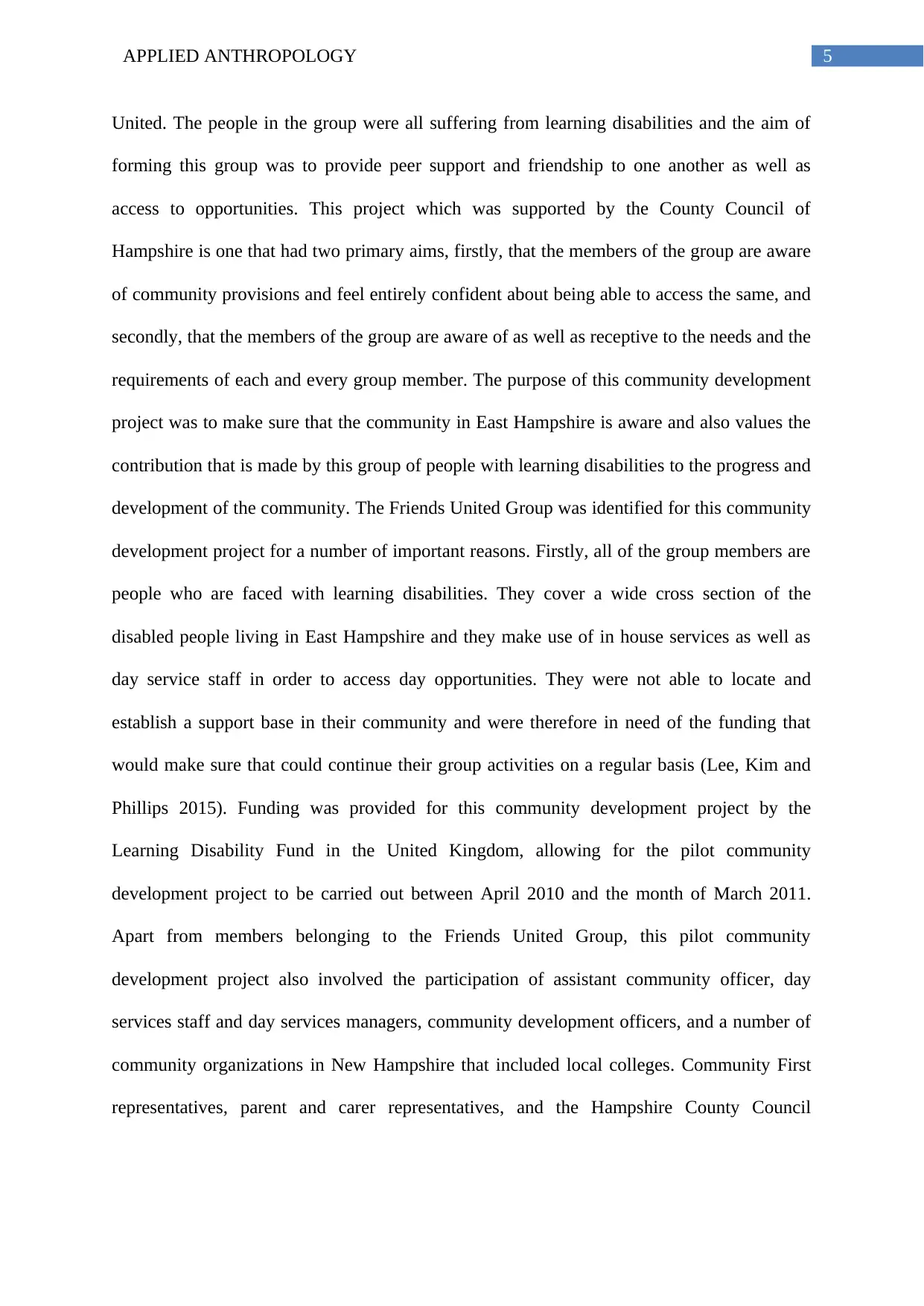
5APPLIED ANTHROPOLOGY
United. The people in the group were all suffering from learning disabilities and the aim of
forming this group was to provide peer support and friendship to one another as well as
access to opportunities. This project which was supported by the County Council of
Hampshire is one that had two primary aims, firstly, that the members of the group are aware
of community provisions and feel entirely confident about being able to access the same, and
secondly, that the members of the group are aware of as well as receptive to the needs and the
requirements of each and every group member. The purpose of this community development
project was to make sure that the community in East Hampshire is aware and also values the
contribution that is made by this group of people with learning disabilities to the progress and
development of the community. The Friends United Group was identified for this community
development project for a number of important reasons. Firstly, all of the group members are
people who are faced with learning disabilities. They cover a wide cross section of the
disabled people living in East Hampshire and they make use of in house services as well as
day service staff in order to access day opportunities. They were not able to locate and
establish a support base in their community and were therefore in need of the funding that
would make sure that could continue their group activities on a regular basis (Lee, Kim and
Phillips 2015). Funding was provided for this community development project by the
Learning Disability Fund in the United Kingdom, allowing for the pilot community
development project to be carried out between April 2010 and the month of March 2011.
Apart from members belonging to the Friends United Group, this pilot community
development project also involved the participation of assistant community officer, day
services staff and day services managers, community development officers, and a number of
community organizations in New Hampshire that included local colleges. Community First
representatives, parent and carer representatives, and the Hampshire County Council
United. The people in the group were all suffering from learning disabilities and the aim of
forming this group was to provide peer support and friendship to one another as well as
access to opportunities. This project which was supported by the County Council of
Hampshire is one that had two primary aims, firstly, that the members of the group are aware
of community provisions and feel entirely confident about being able to access the same, and
secondly, that the members of the group are aware of as well as receptive to the needs and the
requirements of each and every group member. The purpose of this community development
project was to make sure that the community in East Hampshire is aware and also values the
contribution that is made by this group of people with learning disabilities to the progress and
development of the community. The Friends United Group was identified for this community
development project for a number of important reasons. Firstly, all of the group members are
people who are faced with learning disabilities. They cover a wide cross section of the
disabled people living in East Hampshire and they make use of in house services as well as
day service staff in order to access day opportunities. They were not able to locate and
establish a support base in their community and were therefore in need of the funding that
would make sure that could continue their group activities on a regular basis (Lee, Kim and
Phillips 2015). Funding was provided for this community development project by the
Learning Disability Fund in the United Kingdom, allowing for the pilot community
development project to be carried out between April 2010 and the month of March 2011.
Apart from members belonging to the Friends United Group, this pilot community
development project also involved the participation of assistant community officer, day
services staff and day services managers, community development officers, and a number of
community organizations in New Hampshire that included local colleges. Community First
representatives, parent and carer representatives, and the Hampshire County Council
⊘ This is a preview!⊘
Do you want full access?
Subscribe today to unlock all pages.

Trusted by 1+ million students worldwide
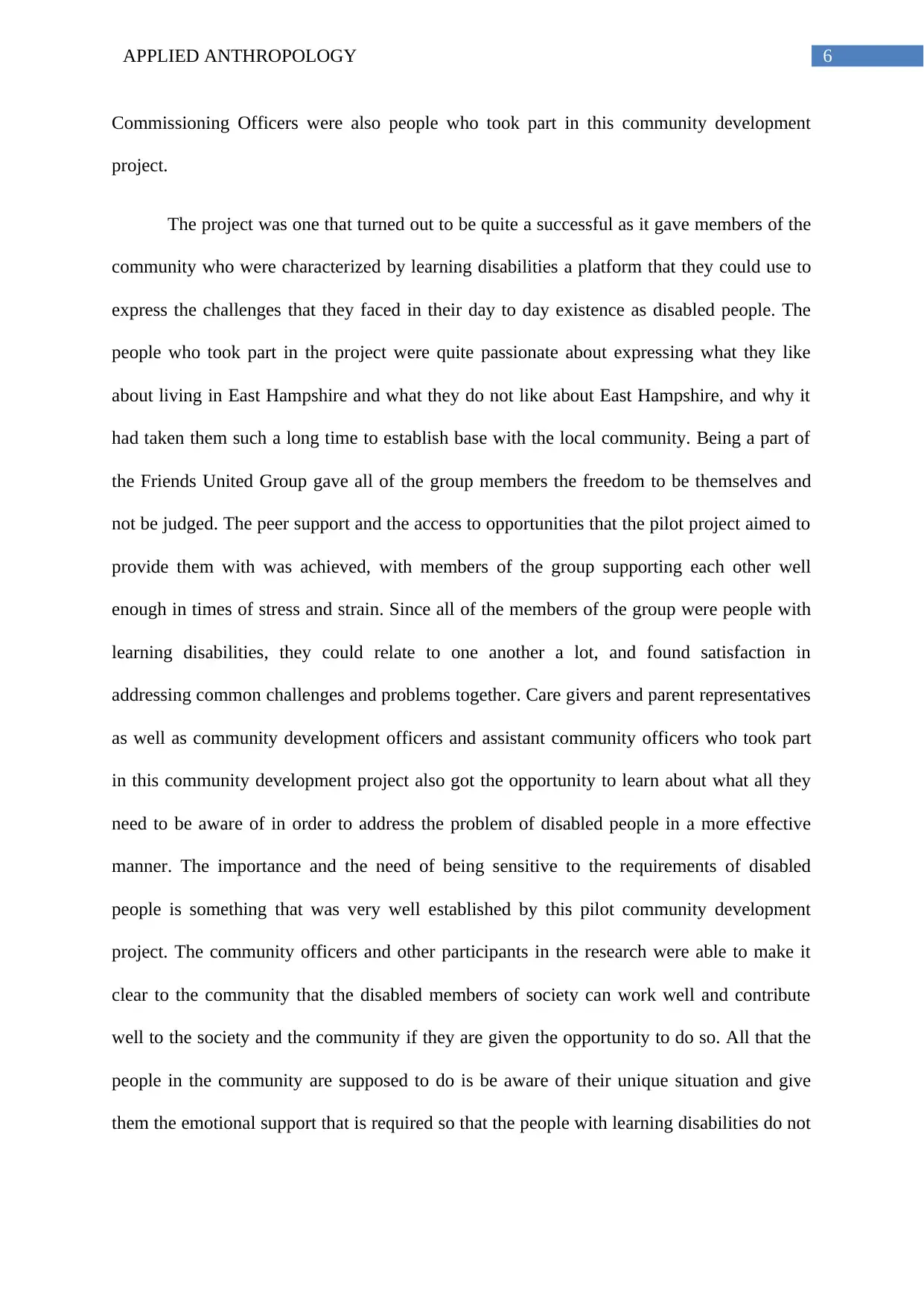
6APPLIED ANTHROPOLOGY
Commissioning Officers were also people who took part in this community development
project.
The project was one that turned out to be quite a successful as it gave members of the
community who were characterized by learning disabilities a platform that they could use to
express the challenges that they faced in their day to day existence as disabled people. The
people who took part in the project were quite passionate about expressing what they like
about living in East Hampshire and what they do not like about East Hampshire, and why it
had taken them such a long time to establish base with the local community. Being a part of
the Friends United Group gave all of the group members the freedom to be themselves and
not be judged. The peer support and the access to opportunities that the pilot project aimed to
provide them with was achieved, with members of the group supporting each other well
enough in times of stress and strain. Since all of the members of the group were people with
learning disabilities, they could relate to one another a lot, and found satisfaction in
addressing common challenges and problems together. Care givers and parent representatives
as well as community development officers and assistant community officers who took part
in this community development project also got the opportunity to learn about what all they
need to be aware of in order to address the problem of disabled people in a more effective
manner. The importance and the need of being sensitive to the requirements of disabled
people is something that was very well established by this pilot community development
project. The community officers and other participants in the research were able to make it
clear to the community that the disabled members of society can work well and contribute
well to the society and the community if they are given the opportunity to do so. All that the
people in the community are supposed to do is be aware of their unique situation and give
them the emotional support that is required so that the people with learning disabilities do not
Commissioning Officers were also people who took part in this community development
project.
The project was one that turned out to be quite a successful as it gave members of the
community who were characterized by learning disabilities a platform that they could use to
express the challenges that they faced in their day to day existence as disabled people. The
people who took part in the project were quite passionate about expressing what they like
about living in East Hampshire and what they do not like about East Hampshire, and why it
had taken them such a long time to establish base with the local community. Being a part of
the Friends United Group gave all of the group members the freedom to be themselves and
not be judged. The peer support and the access to opportunities that the pilot project aimed to
provide them with was achieved, with members of the group supporting each other well
enough in times of stress and strain. Since all of the members of the group were people with
learning disabilities, they could relate to one another a lot, and found satisfaction in
addressing common challenges and problems together. Care givers and parent representatives
as well as community development officers and assistant community officers who took part
in this community development project also got the opportunity to learn about what all they
need to be aware of in order to address the problem of disabled people in a more effective
manner. The importance and the need of being sensitive to the requirements of disabled
people is something that was very well established by this pilot community development
project. The community officers and other participants in the research were able to make it
clear to the community that the disabled members of society can work well and contribute
well to the society and the community if they are given the opportunity to do so. All that the
people in the community are supposed to do is be aware of their unique situation and give
them the emotional support that is required so that the people with learning disabilities do not
Paraphrase This Document
Need a fresh take? Get an instant paraphrase of this document with our AI Paraphraser
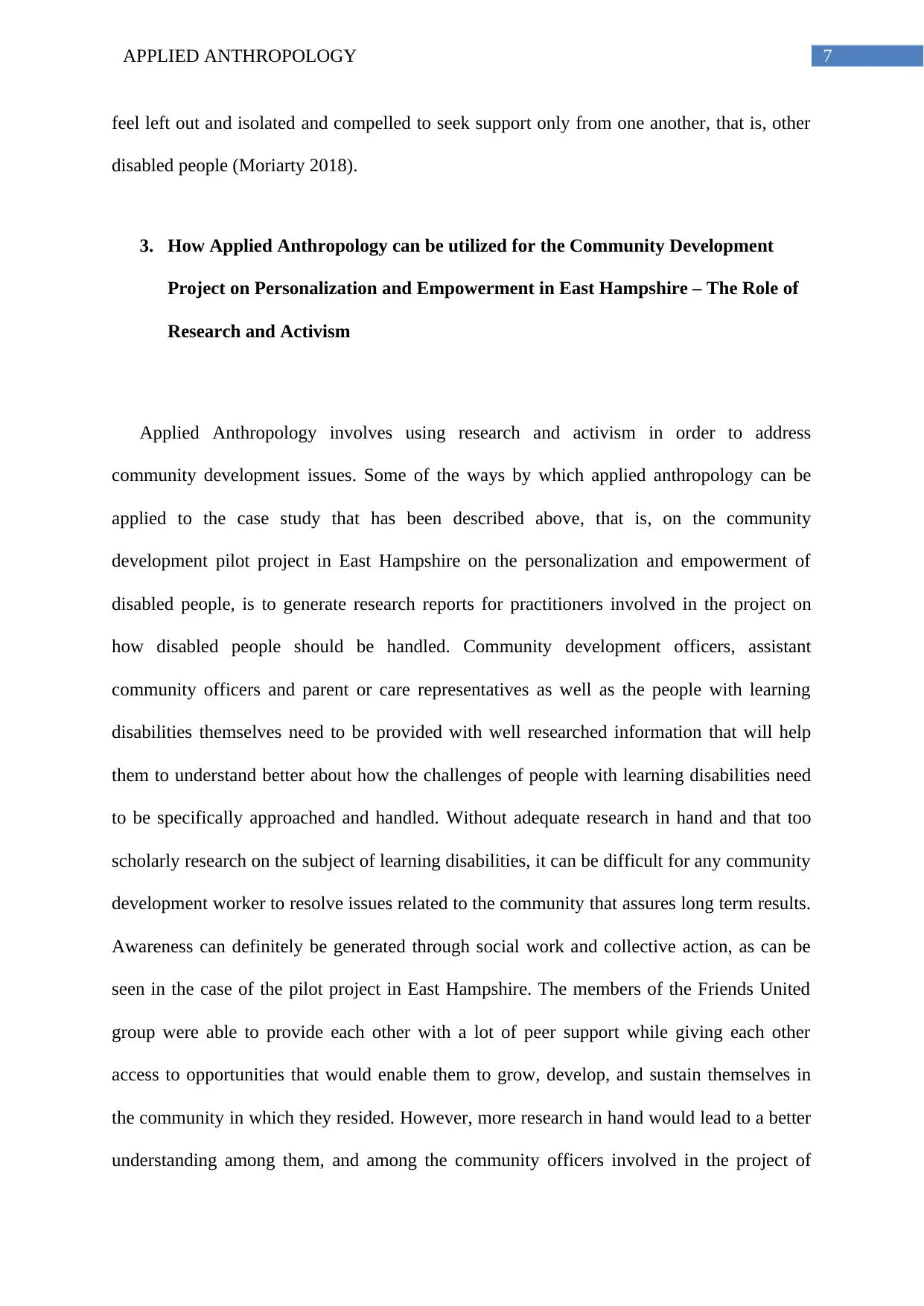
7APPLIED ANTHROPOLOGY
feel left out and isolated and compelled to seek support only from one another, that is, other
disabled people (Moriarty 2018).
3. How Applied Anthropology can be utilized for the Community Development
Project on Personalization and Empowerment in East Hampshire – The Role of
Research and Activism
Applied Anthropology involves using research and activism in order to address
community development issues. Some of the ways by which applied anthropology can be
applied to the case study that has been described above, that is, on the community
development pilot project in East Hampshire on the personalization and empowerment of
disabled people, is to generate research reports for practitioners involved in the project on
how disabled people should be handled. Community development officers, assistant
community officers and parent or care representatives as well as the people with learning
disabilities themselves need to be provided with well researched information that will help
them to understand better about how the challenges of people with learning disabilities need
to be specifically approached and handled. Without adequate research in hand and that too
scholarly research on the subject of learning disabilities, it can be difficult for any community
development worker to resolve issues related to the community that assures long term results.
Awareness can definitely be generated through social work and collective action, as can be
seen in the case of the pilot project in East Hampshire. The members of the Friends United
group were able to provide each other with a lot of peer support while giving each other
access to opportunities that would enable them to grow, develop, and sustain themselves in
the community in which they resided. However, more research in hand would lead to a better
understanding among them, and among the community officers involved in the project of
feel left out and isolated and compelled to seek support only from one another, that is, other
disabled people (Moriarty 2018).
3. How Applied Anthropology can be utilized for the Community Development
Project on Personalization and Empowerment in East Hampshire – The Role of
Research and Activism
Applied Anthropology involves using research and activism in order to address
community development issues. Some of the ways by which applied anthropology can be
applied to the case study that has been described above, that is, on the community
development pilot project in East Hampshire on the personalization and empowerment of
disabled people, is to generate research reports for practitioners involved in the project on
how disabled people should be handled. Community development officers, assistant
community officers and parent or care representatives as well as the people with learning
disabilities themselves need to be provided with well researched information that will help
them to understand better about how the challenges of people with learning disabilities need
to be specifically approached and handled. Without adequate research in hand and that too
scholarly research on the subject of learning disabilities, it can be difficult for any community
development worker to resolve issues related to the community that assures long term results.
Awareness can definitely be generated through social work and collective action, as can be
seen in the case of the pilot project in East Hampshire. The members of the Friends United
group were able to provide each other with a lot of peer support while giving each other
access to opportunities that would enable them to grow, develop, and sustain themselves in
the community in which they resided. However, more research in hand would lead to a better
understanding among them, and among the community officers involved in the project of
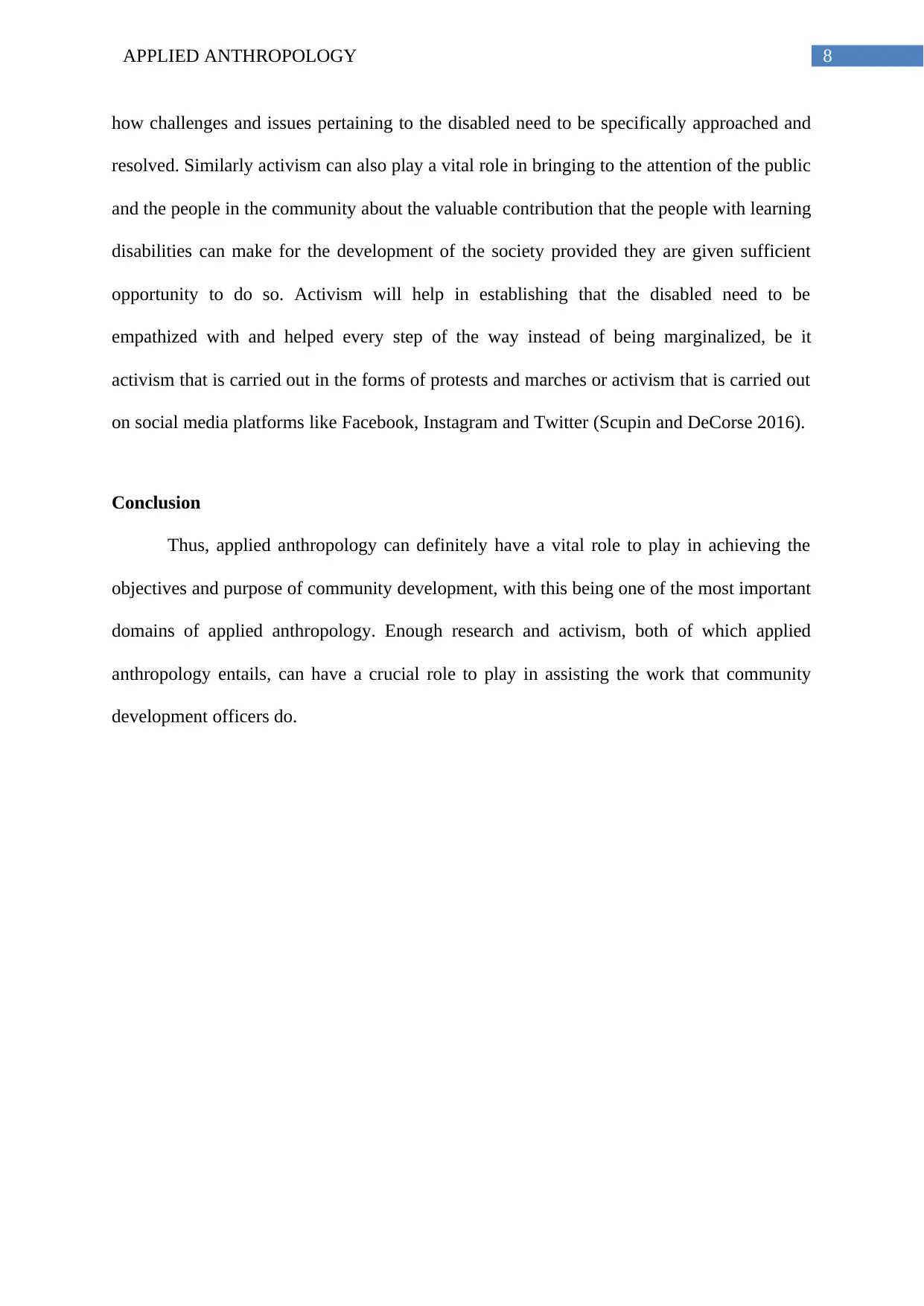
8APPLIED ANTHROPOLOGY
how challenges and issues pertaining to the disabled need to be specifically approached and
resolved. Similarly activism can also play a vital role in bringing to the attention of the public
and the people in the community about the valuable contribution that the people with learning
disabilities can make for the development of the society provided they are given sufficient
opportunity to do so. Activism will help in establishing that the disabled need to be
empathized with and helped every step of the way instead of being marginalized, be it
activism that is carried out in the forms of protests and marches or activism that is carried out
on social media platforms like Facebook, Instagram and Twitter (Scupin and DeCorse 2016).
Conclusion
Thus, applied anthropology can definitely have a vital role to play in achieving the
objectives and purpose of community development, with this being one of the most important
domains of applied anthropology. Enough research and activism, both of which applied
anthropology entails, can have a crucial role to play in assisting the work that community
development officers do.
how challenges and issues pertaining to the disabled need to be specifically approached and
resolved. Similarly activism can also play a vital role in bringing to the attention of the public
and the people in the community about the valuable contribution that the people with learning
disabilities can make for the development of the society provided they are given sufficient
opportunity to do so. Activism will help in establishing that the disabled need to be
empathized with and helped every step of the way instead of being marginalized, be it
activism that is carried out in the forms of protests and marches or activism that is carried out
on social media platforms like Facebook, Instagram and Twitter (Scupin and DeCorse 2016).
Conclusion
Thus, applied anthropology can definitely have a vital role to play in achieving the
objectives and purpose of community development, with this being one of the most important
domains of applied anthropology. Enough research and activism, both of which applied
anthropology entails, can have a crucial role to play in assisting the work that community
development officers do.
⊘ This is a preview!⊘
Do you want full access?
Subscribe today to unlock all pages.

Trusted by 1+ million students worldwide
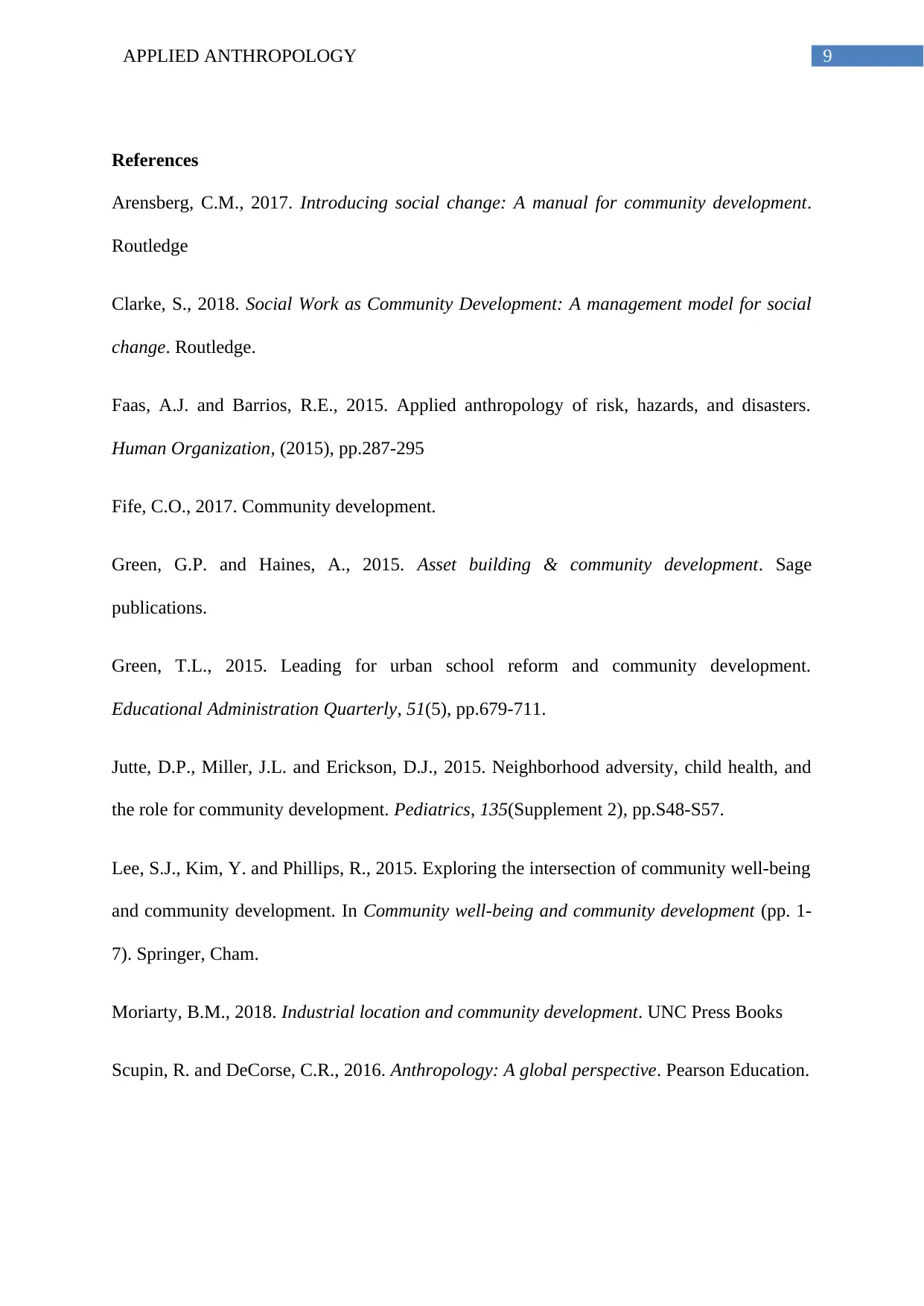
9APPLIED ANTHROPOLOGY
References
Arensberg, C.M., 2017. Introducing social change: A manual for community development.
Routledge
Clarke, S., 2018. Social Work as Community Development: A management model for social
change. Routledge.
Faas, A.J. and Barrios, R.E., 2015. Applied anthropology of risk, hazards, and disasters.
Human Organization, (2015), pp.287-295
Fife, C.O., 2017. Community development.
Green, G.P. and Haines, A., 2015. Asset building & community development. Sage
publications.
Green, T.L., 2015. Leading for urban school reform and community development.
Educational Administration Quarterly, 51(5), pp.679-711.
Jutte, D.P., Miller, J.L. and Erickson, D.J., 2015. Neighborhood adversity, child health, and
the role for community development. Pediatrics, 135(Supplement 2), pp.S48-S57.
Lee, S.J., Kim, Y. and Phillips, R., 2015. Exploring the intersection of community well-being
and community development. In Community well-being and community development (pp. 1-
7). Springer, Cham.
Moriarty, B.M., 2018. Industrial location and community development. UNC Press Books
Scupin, R. and DeCorse, C.R., 2016. Anthropology: A global perspective. Pearson Education.
References
Arensberg, C.M., 2017. Introducing social change: A manual for community development.
Routledge
Clarke, S., 2018. Social Work as Community Development: A management model for social
change. Routledge.
Faas, A.J. and Barrios, R.E., 2015. Applied anthropology of risk, hazards, and disasters.
Human Organization, (2015), pp.287-295
Fife, C.O., 2017. Community development.
Green, G.P. and Haines, A., 2015. Asset building & community development. Sage
publications.
Green, T.L., 2015. Leading for urban school reform and community development.
Educational Administration Quarterly, 51(5), pp.679-711.
Jutte, D.P., Miller, J.L. and Erickson, D.J., 2015. Neighborhood adversity, child health, and
the role for community development. Pediatrics, 135(Supplement 2), pp.S48-S57.
Lee, S.J., Kim, Y. and Phillips, R., 2015. Exploring the intersection of community well-being
and community development. In Community well-being and community development (pp. 1-
7). Springer, Cham.
Moriarty, B.M., 2018. Industrial location and community development. UNC Press Books
Scupin, R. and DeCorse, C.R., 2016. Anthropology: A global perspective. Pearson Education.
1 out of 10
Related Documents
Your All-in-One AI-Powered Toolkit for Academic Success.
+13062052269
info@desklib.com
Available 24*7 on WhatsApp / Email
![[object Object]](/_next/static/media/star-bottom.7253800d.svg)
Unlock your academic potential
Copyright © 2020–2025 A2Z Services. All Rights Reserved. Developed and managed by ZUCOL.





